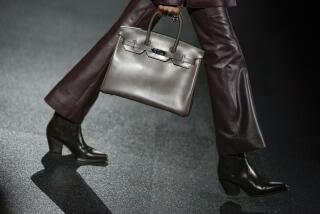Pretenders to the Known : Inexpensive knockoffs of a Chanel bag or Cartier watch will keep you from breaking the bank. Counterfeit items, however, break the law.
- Share via
People don’t always buy the genuine article when trying to obtain a couture look. Some take the inexpensive route with counterfeit and look-alike jewelry and accessories. The line separating a counterfeit and a look-alike is well defined by the law. Look-alikes--which copy the design with some minor changes but don’t pretend to be the real thing--are legal. Counterfeits--with trademark logos intact--are not.
At Kenneth Jay Lane in South Coast Plaza, look-alikes of jewelry and accessories by Chanel, Tiffany and Cartier sell just a few feet away from the genuine article. Unlike counterfeits, these don’t pretend to be real.
A $65 red leather and gold chain belt, for instance, is a dead-ringer for one that sells across the hall at Chanel for about $900. One key difference: the faux belt is missing the Chanel logo.
There’s also a collection of Chanel-style chains with colored stones and faux pearls for $175 to $395--about half the Chanel price.
“Chanel has been wonderful for us because customers can come here and pay $65 for an imitation brooch that might cost $450 there,” says Monique Morel, manager of Kenneth Jay Lane.
She also has bow-shaped earrings that mimic a brooch at Tiffany, but instead of diamonds and sapphires they are made of crystals and blue enamel.
“When you look closely at them they’re definitely not the real thing, but they look beautiful on the ears,” Morel says.
“The effect is truly the same. Of course, if you have a pair of $14,000 earrings on, you will feel really beautiful.”
Imitation Tiffany canary diamond rings sell for $660 here, while the real McCoy sells next door for about $600,000. The great pretender, however, is a cubic zirconia set in silver-plated base metal, while holders of the Tiffany ring have a rare yellow diamond and platinum setting.
Impostors in Brea Mall carries look-alikes of Chanel, Cartier, Rolex and others using cubic zirconia and gold-plated metals.
“We just got in Chanel-like necklaces, and we sold two right away. They’re chains with leather woven through it,” says Marianne Apodaca, store manager. One couple bought their wedding bands at Tiffany, then came to her store for the diamond engagement ring--a look-alike of a Tiffany 1-carat solitaire that they bought for $122. They’d seen the real ring for $16,000.
They were planning to use the money they’d saved for a new car and to tell nobody about the fake diamond.
“I told them, ‘I never saw you in my whole life,’ ” Apodaca says.
Unlike look-alikes, counterfeiters pose a real problem for the legitimate clothing and jewelry companies they copy. They cut into sales and do immeasurable damage to the companies’ most valuable asset--their reputations.
“Counterfeiting is robbery,” says Simon Critchell, president and chief executive officer of Cartier Inc. “We’ve been in business 145 years. Our success is based on workmanship and design. We don’t want our name associated with cheap and inferior merchandise.”
How to recognize a fake Cartier watch?
“First of all, pick it up. The (fakes are) virtually weightless,” Critchell says.
Most are made of cheap metal alloys. A look at the dial often reveals sloppy stamping of the Cartier name (the watches are usually shipped without the logos from the Far East, then illegally stamped with the Cartier signature once they’re in U.S. warehouses). The straps are an immediate give-away. They’re usually made of cheap leather or plastic.
While the fakes sell for $20 or more on the street, their estimated value is $2.50. Genuine Cartier watches range from $900 to $14,000.
Chanel is another favorite target of counterfeiters.
“They take a crummy product, put CCs on it and pass it off as the real thing,” says Arie Kopelman, president and chief executive officer of Chanel Inc., in a telephone interview from Paris. “It doesn’t do any good for our image to have inferior products. Many people believe it’s real but it’s not--buyer beware.”
Some buyers will even bring the fake goods back to Chanel for repairs. One woman tried to return a handbag with the Chanel logo after the leather started to wear and fade.
“She was coming on strong in our boutique,” Kopelman says. “We asked ‘Where did you buy this bag?’ She hemmed and hawed and said she got it as a gift. It was a counterfeit.
“This kind of thing happens a fair amount. It causes us all kinds of aggravation.”
Cheap materials are a telltale sign of a faux Chanel.
“The quality is not at all what our product is all about,” Kopelman says. “Even if they’re making a line-for-line copy of a Chanel suit, no one’s going to put in a silk lining or use quality fabrics or sew a chain into the back of the jacket to make it stable.”
To protect themselves, companies are going after counterfeiters “with guns blazing,” Critchell says.
Chanel and Cartier have their own investigators to track down those who sell or make counterfeit goods and report them to local law enforcement. In California, a first offense is a misdemeanor punishable by a maximum $5,000 fine and probation, and a second offense can be ruled a felony and land one in jail.
While they can fight the illegal use of their name, the companies are virtually powerless when manufacturers use their designs but leave off the trademark and make minor changes in the look.
Chanel’s quilted leather bags with their leather and chain straps are everywhere now--without the logo and often with subtle design changes.
“We cannot protect a quilted bag,” Kopelman says.
Some styles are so popular it’s impossible to keep them from being endlessly duplicated.
“Certain designs are exclusive to Tiffany that we see (reproduced) quite often,” says Jo Ellen Qualls, vice president of Tiffany & Co. in South Coast Plaza. “Paloma Picasso’s scribbles and X’s and O’s are quite readily copied. The issue is whether the user is aware that what they have is not the genuine article. Certain companies can duplicate the look, but they use base metals. There’s nothing precious about it.”
At a clothing store in south Orange County, T-shirts with the Chanel name stitched in gold letters and earrings with Chanel’s interlocking C logo are a favorite of the clientele. Trouble is, this isn’t a Chanel boutique.
The goods are counterfeits. The owner has a vague idea that selling Chanel fakes is illegal but she does it anyway.
“The (legitimate brand manufacturers) are asking an awful lot for these labels,” she says. “A lot of women like the look but don’t want to pay the price.”
Counterfeit couture can be found all over Orange County, if you know where to look.
“We’ve had counterfeit merchandise sold at stores in Fashion Island and Balboa, in homes, at fund-raisers, in hotels and in beauty shops,” says Sgt. Richard Long of the Newport Beach Police Department.
In the fall his department seized and destroyed thousands of dollars worth of bogus Chanel handbags, scarves and clothing found at a boutique in Balboa.
In addition, police seized $120,000 in counterfeit Chanel goods and sewing machinery from a Westminster wholesaler in November, and a raid of a Santa Ana handbag outlet at the Orange County Swap Meet in September yielded more than 5,000 fake Chanel bags.






